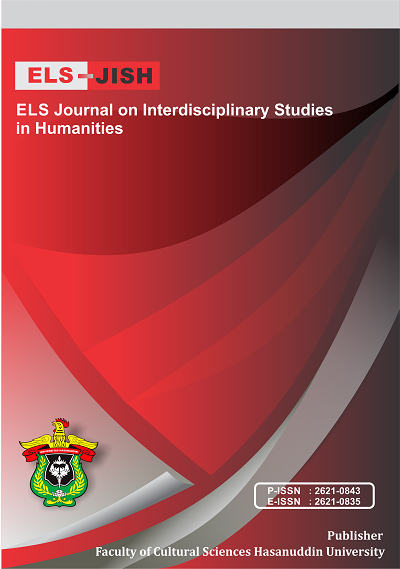Exploring Rani Mehra’S Culture Shock In Queen (2014) Movie Through the Lens of Sverre Lysgaard’S U-Curve Theory
DOI:
https://doi.org/10.34050/elsjish.v7i3.37347Keywords:
Culture shock, Factors, ProcessAbstract
This research explores the processes and underlying factors that lead to culture shock in the main character of the movie Queen (2014), employing Sverre Lysgaard's U-curve theory as the analytical framework. The U-curve model outlines various stages of adaptation that individuals undergo when exposed to a new culture. Through this lens, the study identifies six key phases experienced by the protagonist: before departure, arrival (Honeymoon), the onset of culture shock, feelings of discomfort and unhappiness, gradual adjustment, and eventual completion of the adaptation process. The analysis reveals that the main factors contributing to the character's culture shock include significant differences in cultural norms, unfamiliar food, lifestyle changes, and language barriers. Each of these elements presents unique challenges, which the character must navigate as she transitions into her new environment. This research not only highlights the emotional and psychological shifts during the adaptation process but also underscores the broader impact of intercultural encounters, offering a nuanced understanding of how cultural differences influence personal growth and adaptation in unfamiliar settings.Downloads
References
Almukdad, M., & Karadag, E. (2024). Culture shock among international students in Turkey: an analysis of the effects of self-efficacy, life satisfaction and socio-cultural adaptation on culture shock. BMC psychology, 12(1), 154.
Amelia J, Y., Wen Bin, W., & Fathu Rahman, F. (2024). Vocabulary Mastering of Hanyu Shuiping Kaoshi Level 3 Students of Chinese Language and Culture Study Program Hasanuddin University. ELS Journal on Interdisciplinary Studies in Humanities, 7(3), 410-417. https://doi.org/10.34050/elsjish.v7i3.37181
Davidson, J. (2016). Understanding learning shock: The adult learner's journey back to education. Journal of Adult Education, 45(3), 215-230.
Dewi, S. (2021). Cultural adaptation challenges in Karate Kid: An analysis of Dre Parker’s experiences. Journal of Cultural Studies, 12(2), 45-60.
Fitria, M. (2021). Adapting to culture shock: A study of Shasi in English Vinglish. International Journal of Film Studies, 8(1), 22-35.
Griffiths, R., Winstanley, P., & Gabriel, J. (2004). Learning shock: The impact of returning to education on adults. Studies in Continuing Education, 26(1), 23-39.
Jafarov, S., & Aliyev, Y. (2024). What causes culture shock?. South Florida Journal of Development, 5(7), e4106-e4106.
Junaid, S., & Pertiwi, R. (2015). Exploring culture shock in Torment: A qualitative analysis of psychological states. Journal of Literary Research, 10(3), 100-115.
Junaid, S., Nahdhiyah, N., Dahlan, D., Andini, C., & Muh. Dzulhijjah, A. (2024). The Portrayal of African Woman’s Struggle Reflected in the Novel “How Beautiful We Were” By Imbolo Mbue (2021). ELS Journal on Interdisciplinary Studies in Humanities, 7(2), 275-284. https://doi.org/10.34050/elsjish.v7i2.34882
Junaid, S., Ahmad, Nurhidayah, Mujizat, A., & Andini, C. (2021). The Quality of Human and Non-Human Relation in Indonesia and England Portrayed in the Selected Picture Books. ELS Journal on Interdisciplinary Studies in Humanities, 6(2), 211-218. https://doi.org/10.34050/elsjish.v6i2.26627
Kurnianto, H. (2016). Exploring qualitative research: Understanding events and experiences. Journal of Qualitative Research, 9(1), 12-25.
Lambert, L. (2012). Qualitative descriptive research: A method for understanding complex phenomena. Journal of Research Methodology, 5(2), 45-60.
Lysgaard, S. (1955). Adjustment in a foreign society: Norwegian students in the United States. International Social Science Journal, 7(1), 45-49.
Martin, J. N., & Nakayama, T. (2010). Intercultural communication in contexts (5th ed.). New York, NY: McGraw-Hill.
Minli Wang. (2015). Understanding cultural shock: Insights from narrative analysis. Journal of Cross-Cultural Communication, 9(4), 18-29.
Nuandini, N., & Kustantinah, K. (2022). Billy Wang’s cultural shock in The Farewell: A qualitative study of cultural adaptation. Journal of Intercultural Studies, 15(2), 78-92.
Novinger, T. (2001). Intercultural communication: A practical guide. Austin, TX: University of Texas Press.
Oberg, K. (1960). Cultural shock: Adjustment to new cultural environments. Practical Anthropology, 7(4), 177-182.
Queen. (2014). Directed by Vikas Bahl. India: Viacom18 Motion Pictures.
Weda, S., Rahman, F., Atmowardoyo, H., Samad, I. A., Fitriani, S. S., Said, M. M., & Sakti, A. E. F. (2022). Intercultural Communicative Competence of Students from Different Cultures in EFL Classroom Interaction in Higher Institution. International Journal of Research on English Teaching and Applied Linguistics, 3(1), 1-23.
Youngsun, K., Sosrohadi, S., Andini, C., Jung, S., Yookyung, K., & Kyeong Jae, P. (2024). Cultivating Gratitude: Essential Korean Thankfulness Phrases for Indonesian Learners. ELS Journal on Interdisciplinary Studies in Humanities, 7(2), 248-253. https://doi.org/10.34050/elsjish.v7i2.34881
Zeller, R. A., & Mosier, G. (1993). The W-curve: A model for understanding cultural adaptation in first-year college students. Journal of College Student Development, 34(3), 231-237.
Downloads
Published
How to Cite
Issue
Section
License
Copyright (c) 2024 Syahruni Junaid, Citra Andini, Nissa Atun Atsyania, Aryani Nurul Rahmawati

This work is licensed under a Creative Commons Attribution-ShareAlike 4.0 International License.

















